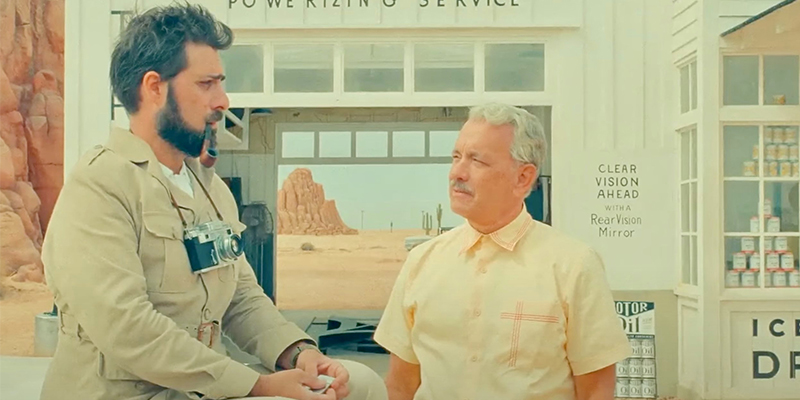When I was watching Asteroid City, the new film from Wes Anderson, I kept thinking of a line from The Fabelmans, the Steven Spielberg movie that came out last year: “in our family, it’s the scientists versus the artists.” Asteroid City is a film about a group of strangers in September 1955 who all wind up in a desert town made famous by an ancient asteroid impact, now populated with scientists doing astronomical research and atomic bomb testing.
It had seemed, from the advertisements, that Asteroid City would be Wes Anderson’s first sci-fi movie, and it is, but it’s also more a film exploring the relationship between science and art—the shared investments of scientists and artists—and how everyone is equally in pursuit of an understanding of what it means to be alive and a part of the universe.
In Asteroid City, a science competition for extraordinary youths presented by the Research and Experimentation Division of the United States Government brings five families to the small town of Asteroid City, which doesn’t have much besides the military science facility, a diner, a hotel, and the asteroid itself. We learn the most about the Steenbeck family: the father Augie (an excellent Jason Schwartzman) and his son Woodrow, or “Brainiac” (Jake Ryan), and his three mischievous little girls.
Augie, a former war photographer, doesn’t know how to tell his kids that their mother has passed away from her long illness three weeks before they began their trip to take Woodrow to the award ceremony of the science competition in which he is a finalist. Unsure how to handle things, Augie calls his father-in-law, Stanley Zak (Tom Hanks), to watch the girls. Woodrow, meanwhile, has befriended the four other nerdy finalists—especially Dinah (Grace Edwards), the daughter of movie star Midge Campbell (Scarlett Johansson).
Asteroid City, the place, is a visual portmanteau of different eras of the American West—part John Ford cowboy-canyon vista, part Los Alamos (the secret pop-up town in New Mexico where the Manhattan Project built the Atom Bomb), part 50s Palm Springs retreat, part Looney Tunes Road Runner cartoon. And it is in this place, at a moment when teen geniuses, rowdy kids, scientists, cowboys, military officers, teachers, and parents all gather for the unveiling of America’s greatest future scientist, that the town gets a visit from an alien who wants the asteroid back.
The film is a retro-futuristic treat, a creative throwback extraterrestrial invasion movie, festooned with the hallmarks of a 50s sci-fi B-feature. And yet, it’s something else entirely. I don’t usually feel the need to discuss the theater viewing experience of a movie I’m reviewing, but I will say that, as I was exiting the theater, I overheard a group of guys behind me express frustration at the film’s large-scale existential focus, because they had hoped Asteroid City was going to be a more charming Mars Attacks! and their hopes had been dashed.
Indeed, the promotional materials do not prepare us for the big twist of Asteroid City, which happens in the literal first second of the movie: a Twilight Zone-seeming frame narrative that isn’t ultimately Twilight Zone-esque at all, one that dramatically changes the genre of Asteroid City from sci-fi tribute to something far more meta and philosophical, transitioning not between different levels of reality, but between different levels of imagination and inquiry. It is about, in the words of one character, “infinity, and I don’t know what else.”
I won’t say what is really going on here, but I will say that this dimension allows Asteroid City to really, really be about how humans search for meaning, and how we deal with phenomena we do not understand. The film is about not knowing what to do when we are confronted by the limits of our knowledge and analytical ability. It is about trying to discover something deeper about our roles, our parts, ourselves—trying to gain control and form structures to handle the near-torturous mystery of life. (Nothing better epitomizes this than a character who divvies up the desert into housing plots and sells that real-estate via vending machine.)
After seeing the film, I wish I had counted how many times characters say the words “I think”—there are lots of sentences like “I think I know now what I realize we are,” rhetorical gestures of uncertainty and the struggle for discovery and the exertion of introspection. The film’s script, which was written by Anderson from a story he co-created with Roman Coppola, is one of his sharpest and most ambitious.
As always with Wes Anderson films, which feature large ensemble casts and numerous spectacular setpieces, Asteroid City is in large part about being part of a production, and what that means. In movies in which everyone’s role is relatively small and there are no call-sheets on set, everyone must work together to make the movie what it is. In this film, being part of a production is just like being a part of human civilization—we all have our little parts to play in the grand scheme of things, and no one is more important than any other. Sometimes we wait around for our purpose, and sometimes, we wonder what our purpose even is.
But it’s not a dark film. Tonally or optically. Mostly, except for a few black-and-white interludes, Asteroid City is a bright, sherbert-colored movie—a visual carnival of oranges, yellows, and turquoises. Like all Anderson films, it is a film about trying to make human connection, and visually, we are instructed not to be afraid of what we don’t understand about all the forces in the universe: time, space, death, being, love. It brings these big questions down to tangible examples; this is a film with multiple love stories and many, many parent-child relationships. It is about reaching for one another amid the strangeness, the unknowability of the universe, and finding someone just like you reaching back.
